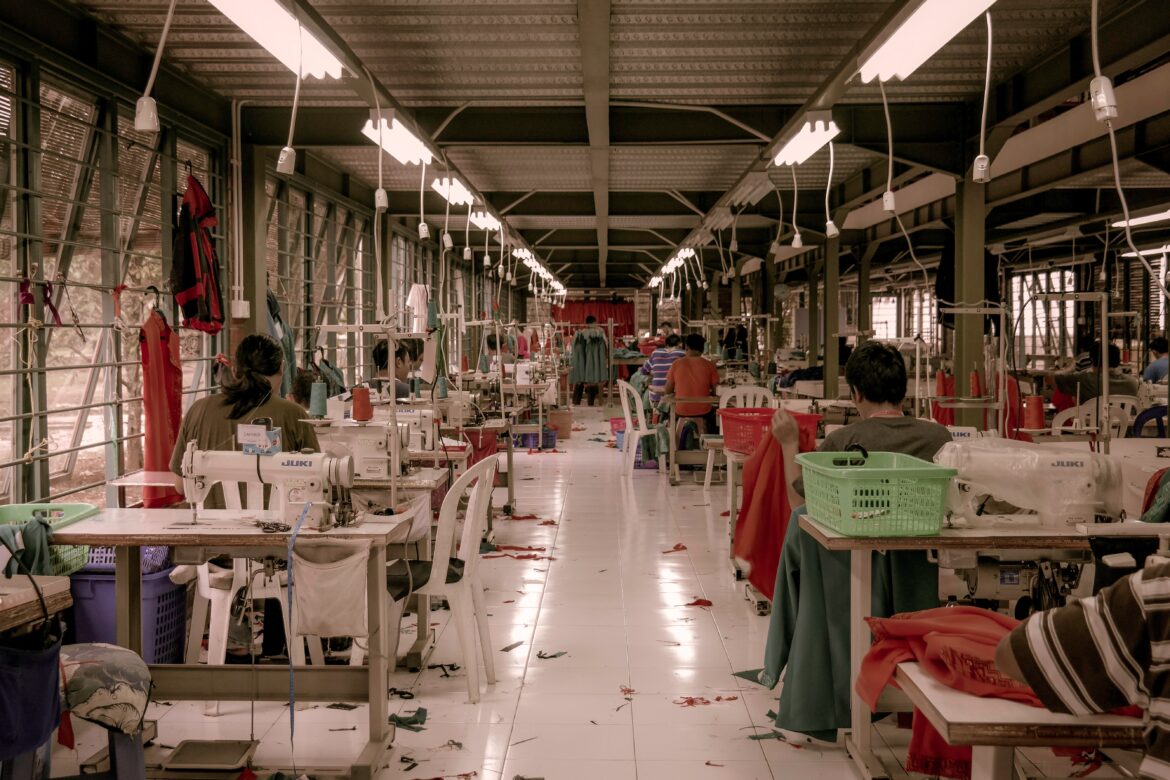Ultra fast-fashion brand Shein currently has over 600,000 items available for sale on their website, with some selling for as little as $1.00. Almost all mainstream clothing companies follow a fast fashion business model, producing inexpensive clothing that prioritises rapidly changing trends and high turn-around times over long-term sustainability and durability.
This shift from a conventional two-to-six-season fashion cycle to a 52-micro-season cycle where hundreds of new pieces are released daily does not come without a serious cost. The process of production, transportation, and disposal of cheap clothes has devastating consequences for both the environment and worker’s rights. Glamorous marketing campaigns conceal labour-rights violations and climate inequality that doubly burden women in the Global South. Brands like Zara, Gap, and Forever 21 produce and sell somewhere between 80 billion and 150 billion garments per year. This fast-paced mass-production model threatens women’s empowerment, labour rights, and climate justice. If brands within the fashion industry moved to embrace sustainable and ethical practices, this could help promote these essential values.
In 2013, the Rana Plaza garment factory in Bangladesh collapsed, killing 1,134 mostly female workers and injuring 2,500 more. This was the deadliest garment factory disaster ever, sparking outrage and calls for increased accountability from fashion brands. Despite global concerns, injuries and deaths in fires and other health and safety incidents continue to pervade unsound manufacturing facilities. The fast fashion labour market is characterised by unpaid overtime work, unsafe working conditions, and subminimum wages, linked to poor physical and mental health. Women make up the vast majority of garment workers. By some estimates, women workers represent 60 to 80 percent of the workforce. Female garment workers face gender-based discrimination, violence, and harassment. Because the majority of leadership and supervisory positions are held by men, women are left with little decision-making power and autonomy. Stories of constant harassment by upper-level management are countless. One woman in Bangladesh describes times when she was “physically and mentally tortured by the factory authority.” There are few effective reporting mechanisms in place and women have limited opportunities for freedom of association. This creates a culture of silence and fear around reporting mistreatment because when workers report gender-based violence they often face job loss or increased harassment. Current processes, such as voluntary codes of conduct and internal grievance mechanisms are inadequate at meaningfully addressing abuse. Multinational corporations bypass accountability by taking advantage of complex supply chains to outsource their manufacturing to third-party subcontractors, avoiding liability for widespread human rights abuses in a system with little governmental oversight.
The production, transportation, and disposal of fast fashion garments create devastating environmental impacts. The international production of billions of pieces of clothing annually contributes to significant resource depletion. One cotton t-shirt can use over 650 gallons of water. Production also contributes to pollution by contaminating water with synthetic dyes and releasing millions of tons of carbon emissions. Carbon emissions are magnified by global shipping and transportation. By some estimates, the apparel and footwear industries account for 8.1% of worldwide climate impacts or 3,990 million metric tons of carbon dioxide. Additionally, fast fashion companies rely on planned obsolescence, whereby pieces of clothing simultaneously go out of style and physically deteriorate, forcing consumers to continually buy more. When clothing becomes unwearable in just a few months, it often ends up in a landfill, exacerbating environmental concerns.
At every step of the fashion cycle, these environmental harms disproportionately impact women in the Global South. Environmental degradation is closely connected with gendered issues. For instance, toxic dyes in clothing impact the health of mostly female garment workers who lack adequate protective clothing. When dyes degrade access to clean drinking water, it harms women in countries where social norms delegate the responsibility of obtaining clean water to women. Changing climates and global warming are also important factors to consider. To begin with, shifting weather patterns and crop failures can increase food insecurity, particularly in cases where women already have little access to productive assets and agricultural land. When climate-related extreme weather events, such as hurricanes, droughts, and floods occur, women are tasked with additional unpaid caregiving responsibilities. In the event of migration following a climate disaster, socio-cultural gender norms limit women’s opportunities to migrate safely and increase their risks of discrimination and gender-based violence at all stages of displacement.
Brands willfully ignore exploitation and environmental damage while performatively claiming to make a difference. Greenwashing is a marketing strategy whereby brands highlight environmental initiatives, without making concrete changes to their business model. H&M’s recent Looop initiative, for instance, created a machine designed to transform recycled garments into new pieces. This flashy campaign however, does little to substantively address the environmental damage created by the 3 billion garments they produce annually.
There is a clear need for a holistic, gender-inclusive approach that addresses labour rights and climate justice as interconnected issues. Women lack representation in leadership and decision-making power. Female garment workers face a dual burden of occupational hazards and climate concerns. To truly protect workers’ rights and climate justice, women need more access to collective bargaining and empowerment. Grassroots movements and community empowerment can lead the way for formal accountability structures and legislation. Bengali women, for instance, are leading a movement to support collective bargaining and unionisation. In Lesotho, female garment workers successfully negotiated a binding agreement with clothing companies, labour unions, and suppliers to prevent gender-based violence and harassment. Additionally, consumers can support the ethical consumption of fashion by minimising excessive purchases and buying clothing second-hand. These individual choices can lead the way for systemic change by challenging ‘throwaway culture’ and reducing financial support for fast fashion companies. As consumers, we have a responsibility to be conscientious of where our clothing comes from and the systemic injustices that underlie their production.
Edited by Emma Benoudiz
Mia Alexander is in her second year at McGill University, currently pursuing a B.A. Joint Honours in International Development Studies and Political Science. She is particularly interested in gender equality and climate justice.

